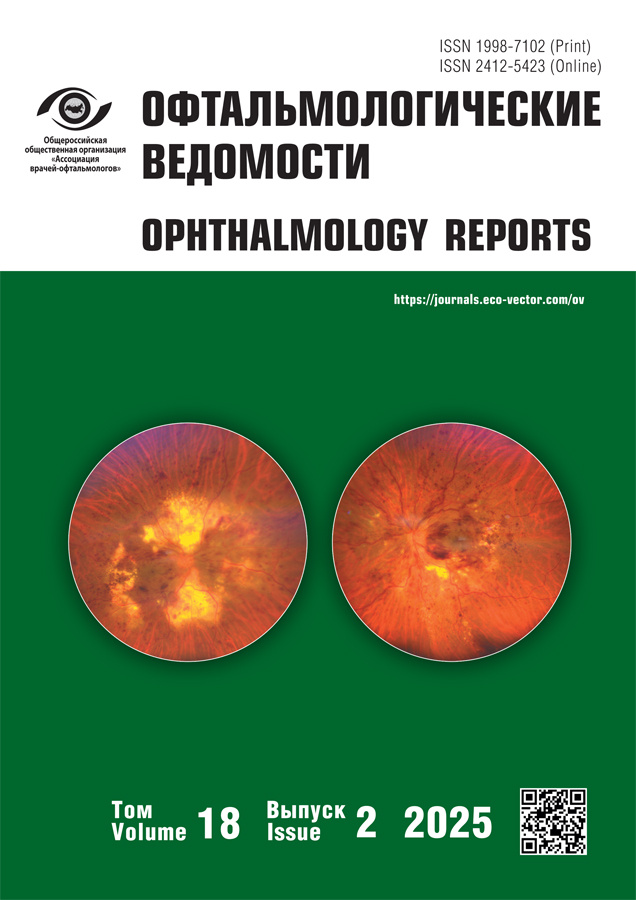Comparative analysis of visual evoked potentials obtained using Tomey EP-1000 and Diopsys Nova in healthy participants
- Authors: Chuprov A.D.1, Trubnikov V.A.1, Zhediale N.A.2, Pligina O.V.1, Subkhankulova A.R.1, Pidodniy E.A.1, Strekalovskaya A.D.3
-
Affiliations:
- Orenburg branch of The S. Fyodorov Eye Microsurgery Federal State Institution
- Clinic “Sozvezdie oftal’mika”
- Orenburg State University
- Issue: Vol 18, No 2 (2025)
- Pages: 27-34
- Section: Original study articles
- Submitted: 20.09.2024
- Accepted: 17.02.2025
- Published: 18.07.2025
- URL: https://journals.eco-vector.com/ov/article/view/636297
- DOI: https://doi.org/10.17816/OV636297
- EDN: https://elibrary.ru/ZNIBRS
- ID: 636297
Cite item
Abstract
BACKGROUND: A visual evoked potential test is a common method of electrophysiological examination in ophthalmology. There are no published Russian scientific comparative studies of the results of the visual evoked potential test obtained using different devices.
AIM: The work aimed to perform a comparative analysis of visual evoked potentials obtained using Tomey EP-1000 and Diopsys Nova in healthy participants.
METHODS: The study included a total of 15 patients (30 eyes). The following parameters of visual evoked potentials were assessed: N75/N80 (Tomey EP-1000), P100, and N135 peak latency and P100 and N135 peak amplitude.
RESULTS: The means of the evaluated parameters obtained using Diopsys Nova were higher than those obtained using Tomey EP-1000, except for P100 peak amplitude. A Bland–Altman analysis showed that the mean difference between the P100 peak amplitude values recorded using Diopsys Nova and Tomey EP-1000 was −0.3 μV, and agreement limits of the evaluated parameters varied quite greatly (−5.66 to 4.99 μV). The P100 peak latency varied even greatly and the mean difference between measurements was 3.5 ms, with the quite wide limit of agreement (−4.29 to 11.35 ms).
CONCLUSION: The mean latencies of N70 (pattern 32), P100 (patterns 32 and 64), and P135 (pattern 32) peaks obtained using Diopsys Nova were statistically significantly higher than those recorded using Tomey EP-1000. The obtained results demonstrated that the used measurement methods were inconsistent. However, the performed study is greatly limited by the small sample size, which is a key for interpreting the results. Therefore, to demonstrate that the two methods are consistent, the sufficient sample size should be determined.
Full Text
About the authors
Aleksandr D. Chuprov
Orenburg branch of The S. Fyodorov Eye Microsurgery Federal State Institution
Email: nauka@ofmntk.ru
ORCID iD: 0000-0001-7011-4220
MD, Dr. Sci. (Medicine), Professor
Russian Federation, OrenburgV. A. Trubnikov
Orenburg branch of The S. Fyodorov Eye Microsurgery Federal State Institution
Author for correspondence.
Email: v.trubnikov@mail.ofmntk.ru
ORCID iD: 0000-0002-9451-8622
SPIN-code: 2002-1951
MD, Cand. Sci. (Medicine)
Russian Federation, OrenburgNatalia A. Zhediale
Clinic “Sozvezdie oftal’mika”
Email: natalex.nnov@mail.ru
ORCID iD: 0000-0002-4012-1056
Russian Federation, Nizhniy Novgorod
Olga V. Pligina
Orenburg branch of The S. Fyodorov Eye Microsurgery Federal State Institution
Email: pliginaolga@mail.ru
ORCID iD: 0000-0001-9956-3556
MD
Russian Federation, OrenburgAliya R. Subkhankulova
Orenburg branch of The S. Fyodorov Eye Microsurgery Federal State Institution
Email: aliya.subkhankulova@gmail.com
ORCID iD: 0000-0003-0913-6660
MD
Russian Federation, OrenburgEkaterina A. Pidodniy
Orenburg branch of The S. Fyodorov Eye Microsurgery Federal State Institution
Email: kati-makulova@yandex.ru
ORCID iD: 0000-0001-9945-3293
SPIN-code: 9230-8651
MD
Russian Federation, OrenburgAlevtina D. Strekalovskaya
Orenburg State University
Email: mbt@mail.osu.ru
ORCID iD: 0000-0003-0850-2091
SPIN-code: 9374-2964
MD, Cand. Sci. (Biology), Assistant Professor
Russian Federation, OrenburgReferences
- Kazajkin VN, Ponomarev VO, Lizunov AV, et al. The current role and prospects of electrophysiological research methods in ophthalmology. Literature review. Ophthalmology in Russia. 2020;17(4):669–675. doi: 10.18008/1816-5095-2020-4-669-675 EDN: ZMXCPU
- Kurysheva NI, Maslova EV. Electrophysiology in glaucoma diagnostics. National Journal of Glaucoma. 2017;16(1):102–113. EDN: YHDHYJ
- Rosolen SG, Kolomiets B, Varela O, Picaud S. Retinal electrophysiology for toxicology studies: applications and limits of ERG in animals and ex vivo recordings. Exp Toxicol Pathol. 2008;60(1):17–32. doi: 10.1016/j.etp.2007.11.012.
- Constable PA, Bach M, Frishman LJ, et al. International Society for Clinical Electrophysiology of Vision. ISCEV Standard for clinical electro-oculography (2017 update). Doc Ophthalmol. 2017;134(2):155. doi: 10.1007/s10633-017-9580-3
- Sheludchenko VM, Ronzina IA, Sheremet NL, et al. Capabilities of modern methods of electrophysiological analysis in diseases of visual analyzer. Russian annals of ophthalmology. 2013;129(5):4352. EDN: RBLYAL
- Mermeklieva EA. Reference values of pattern reversal visual evoked potentials in Bulgarian population. Eur J Ophthalmol. 2019;29(6):600–605. doi: 10.1177/1120672118802545
- Jeon J, Oh S, Kyung S. Assessment of visual disability using visual evoked potentials. BMC Ophthalmol. 2012;12:36. doi: 10.1186/1471-2415-12-36.
- Walsh P, Kane N, Butler S. The clinical role of evoked potentials. J Neurol Neurosurg Psychiatry. 2005;76(S2):ii16-ii22. doi: 10.1136/jnnp.2005.068130
- Odom JV, Bach M, Brigell M, et al. International Society for Clinical Electrophysiology of Vision. ISCEV standard for clinical visual evoked potentials: (2016 update). Doc Ophthalmol. 2016;133(1):1–9. doi: 10.1007/s10633-016-9553-y
- Willeford KT, Ciuffreda KJ, Yadav NK, Ludlam DP. Objective assessment of the human visual attentional state. Doc Ophthalmol. 2012;126(1):29–44. doi: 10.1007/s10633-012-9357-7.
- Koshelev DI, Galautdinov MF, Vakhmyanina AA. The practice of the application of the flash visual evoked potentials for the visual system’s evaluation. Vestnik of the Orenburg State University. 2014;(12):181–187. EDN: TUOAYH
- Willeford KT, Ciuffreda KJ, Yadav NK. Effect of test duration on the visual-evoked potential (VEP) and alpha-wave responses. Doc Ophthalmol. 2013;126(2):105–115. doi: 10.1007/s10633-012-9363-9
- De Freitas Dotto P, Berezovsky A, Sacai PY, et al. Gender-based normative values for pattern-reversal and flash visually evoked potentials under binocular and monocular stimulation in healthy adults. Doc Ophthalmol. 2017;135(1):53–67. doi: 10.1007/s10633-017-9594-x
- Trevino RC, Majcher CE, Henry AM, et al. Visual evoked potential repeatability using the Diopsys NOVA LX fixed protocol in normal older adults. Clin Ophthalmol. 2018;12:1713–1729. doi: 10.2147/OPTH.S166211
- Altman DG, Bland JM. Statistical methods for assessing agreement between two methods of clinical measurement. Lancet. 1986;327(8476):307–310. doi: 10.1016/S0140-6736(86)90837-8
Supplementary files










